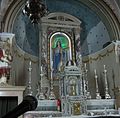Church of Saint John the Baptist, Ein Karem
| Church of Saint John the Baptist, Ein Karem | |
|---|---|
 Exterior view | |
| Religion | |
| Affiliation | Roman Catholic |
| Leadership | Franciscans |
| Location | |
| Location | Ein Karem, Jerusalem |
| Palestine grid | 1655/1307 |
| Geographic coordinates | 31°46′05″N 35°09′47″E / 31.76806°N 35.16306°E |
| Architecture | |
| Architect(s) | Antonio Barluzzi |
| Completed | 1113, 1621-1675, 1939 |
The Church of Saint John the Baptist is a Catholic church in Ein Karem, Jerusalem, that belongs to the Franciscan order. It was built at the site where Saint John the Baptist was believed to have been born.[1]
History
The Church of St. John, or of the Magnificat, is mentioned in 1113 CE in Ein Karem.[2]
In 1480 Felix Fabri reported it as tall, vaulted, and still painted, but turned into a stable for animals.[3]
Ottoman era
In the 1670s, the village was given to the Franciscans through the influence of the Marquis de Nointel, the French Ambassador to the Ottoman Empire.[4][5]
In 1697 Henry Maundrell noted that: "The Convent of St John has been within these four years rebuilt from the ground. It is at present a large square building, uniform and neat all over; but that which is most eminently beautiful in it is it's Church. It consists of three Isles, and has in the middle an handsome Cupola, under which is a pavement of Mosaick, equal to, if not exceeding the finest works of the Ancients in that kind. At the upper end of the North Isle, you go down seven Marble steps, to a very splendid Altar, erected over the very place where they say the holy Baptist was Born. Here are Artificers still employed, in adding farther beauty and ornament to this Convent."[6]
James Silk Buckingham visited in the early 1800s, and found the convent "appeared to be superior in comfort and arrangement to that of Jerusalem, and equal to that of Nazareth. The church is one of the most simply beautiful throughout the Holy Land. As the friars are all Spaniards, it partakes more of the style of that nation than any other, in its ornaments."[7]
In 1883, the Palestine Exploration Fund's Survey of Western Palestine (SWP) noted: "The Church of the Baptist, in the village itself, is of Crusading origin; but the interior has been covered with encaustic tiles, and none of the older work is recognizable. The dome rises from four heavy piers ; the grotto north of the high altar (at the east end of the church), is reached by seven steps; it is said to be the birthplace of St. John. A bad copy of a Murillo is hung on the north side of the church, and much prized by the monks, who are chiefly Spaniards".[8]
Present Church plan

- 1. Cave of John the Baptist's birth[9]
- The red is from the Byzantine era
- The yellow is the church is in the 11th and 12th centuries
- The green is Crusader Halls (12th century)
Gallery
-
Exterior
-
The altar in the church
-
The altar and cupola in the church
-
The altar and cupola in the church
-
The cupola in the church
-
Part of the cupola in the church
-
Entrance of the cave of John the Baptist's birth
-
Entrance of the cave of John the Baptist's birth
-
The floor tiles in the cave
-
The floor tiles in the cave
-
Cave of John the Baptist's birth
See also
References
- ^ Israel & the Palestinian Territories (Lonely Planet, 2012) ISBN 978-1741799361
- ^ Conder and Kitchener, 1883, SWP III, p. 20
- ^ Fabri, 1896, pp. 638-639; cited in Pringle, 1993, p. 32
- ^ Conder and Kitchener, 1883, SWP III, p. 61
- ^ Pringle, 1993, p. 32
- ^ Maundrell, 1703, p. 92
- ^ Buckingham, 1821, pp. 228-229
- ^ Conder and Kitchener, 1883, SWP III, pp. 60-61
- ^ Pringle, 1993, p. 34
Bibliography
- Buckingham, J.S. (1821). Travels in Palestine Through the Countries of Bashan and Gilead, East of the River Jordan, Including a Visit to the Cities of Geraza and Gamala in the Decapolis. London: Longman.
- Conder, C.R.; Kitchener, H.H. (1883). The Survey of Western Palestine: Memoirs of the Topography, Orography, Hydrography, and Archaeology. Vol. 3. London: Committee of the Palestine Exploration Fund.
- Fabri, F. (1896). Felix Fabri (circa 1480–1483 A.D.) vol I, part II. Palestine Pilgrims' Text Society.
- Maundrell, H. (1703). A Journey from Aleppo to Jerusalem: At Easter, A. D. 1697. Oxford: Printed at the Theatre.
- Pringle, Denys (1993). The Churches of the Crusader Kingdom of Jerusalem: A-K (excluding Acre and Jerusalem). Vol. I. Cambridge University Press. ISBN 0 521 39036 2.
- Saewolf (1892). Saewolf (A.D. 1102, 1103). Palestine Pilgrims' Text Society.
External links
- St. John Ba Harim, at BibleWalks.com
- Ain Karem: Saint John the Baptist, at custodia.org











